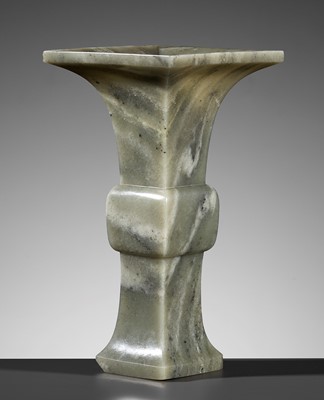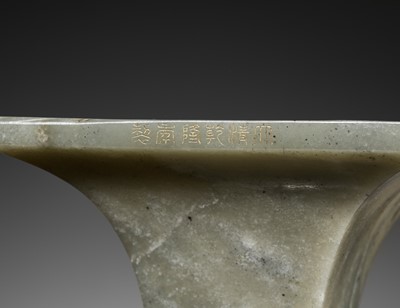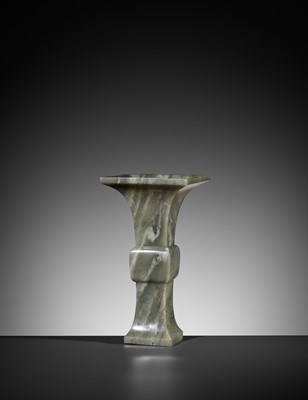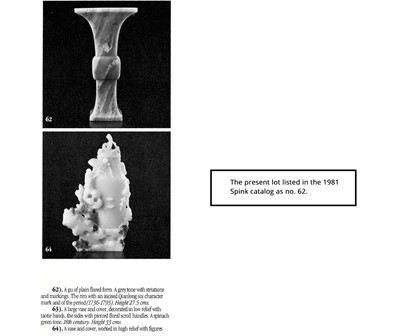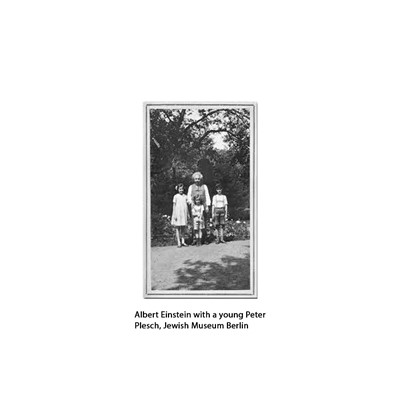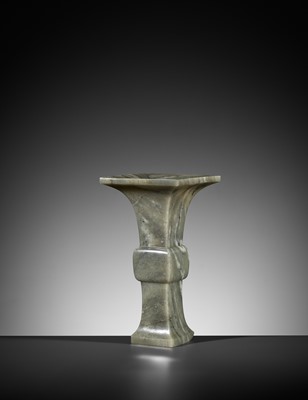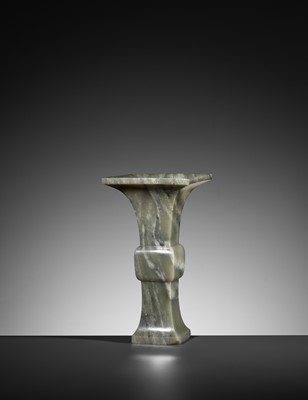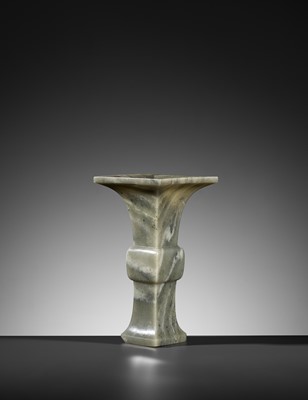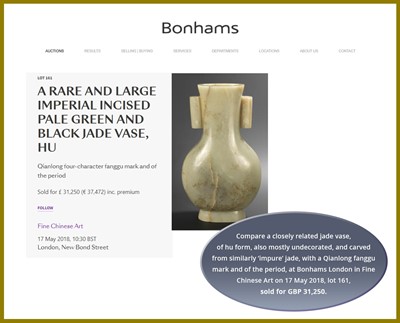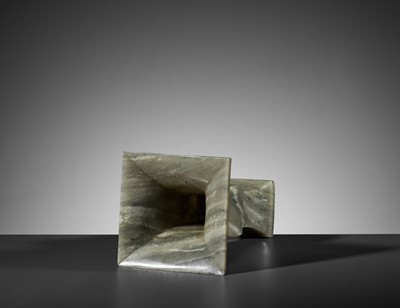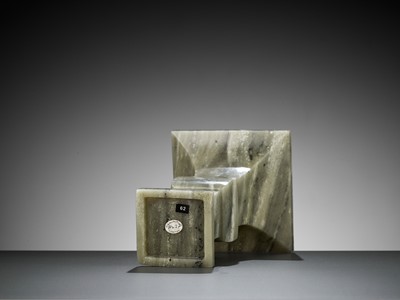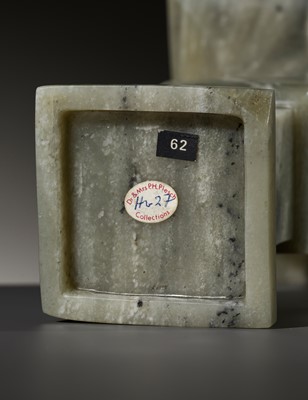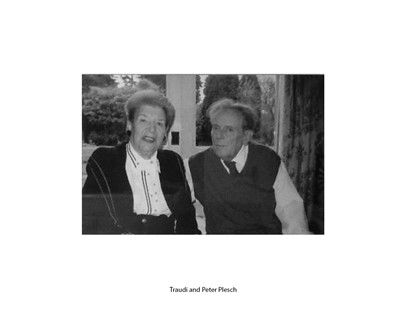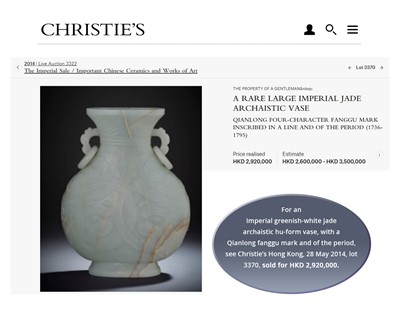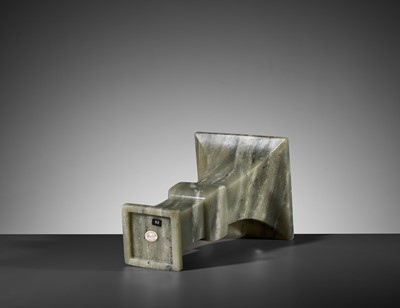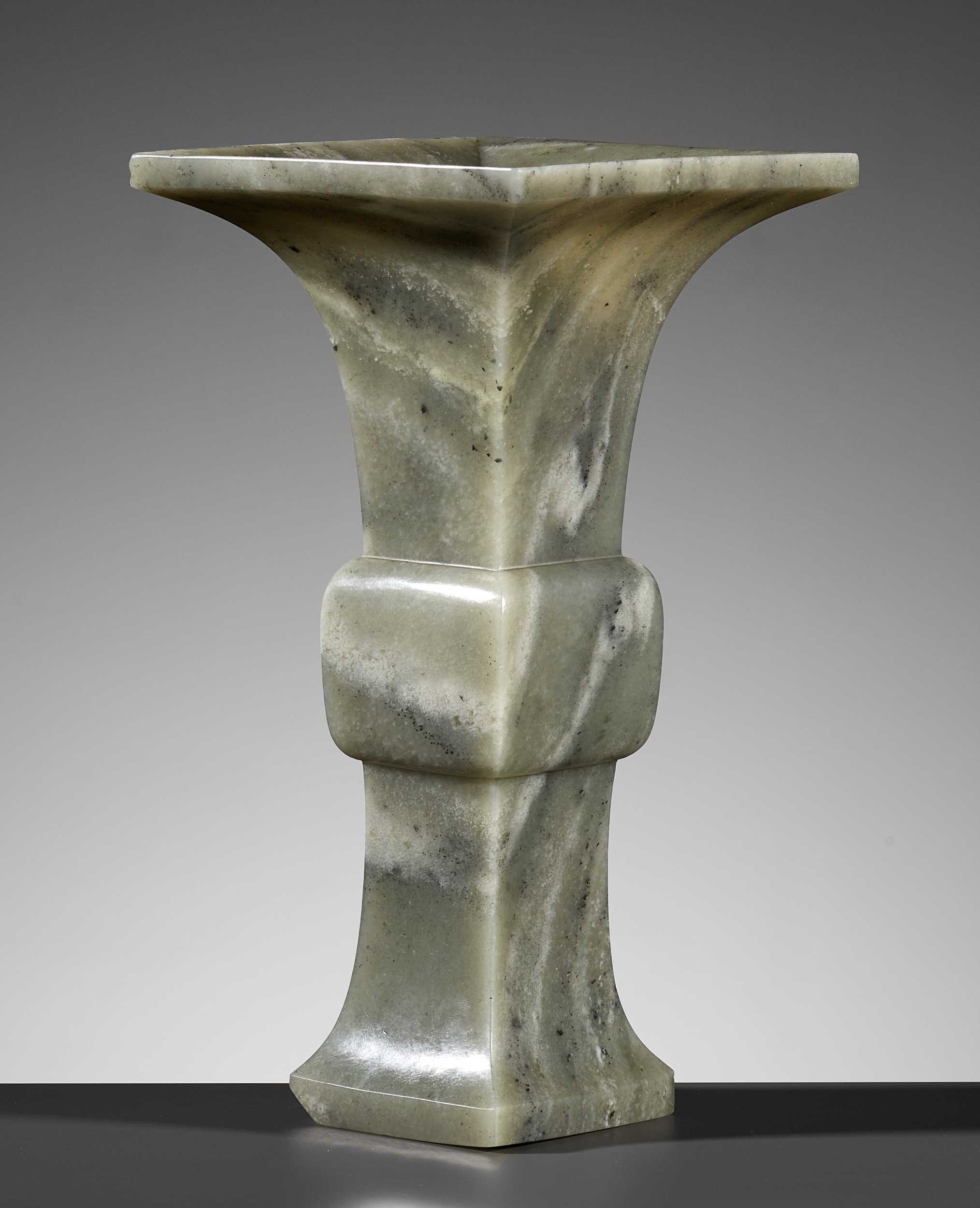11th Mar, 2022 10:00
DAY 2 - TWO-DAY AUCTION - Fine Chinese Art / 中國藝術集珍 / Buddhism & Hinduism
444
A CELADON JADE ‘ARCHAISTIC’ VASE, FANG GU, QIANLONG MARK AND PERIOD
乾隆款及年代素面青玉方觚
Sold for €13,904
including Buyer's Premium
China, 1736-1795. Of square section, supported on a thick foot, tapering toward the bulbous mid-section and flaring to the everted rim. The vase is undecorated, leaving the viewer only with the mesmerizing appearance of the translucent jade of celadon tone with gray shadings as well as striated bands of fine black and white specks. The rim with a neatly incised and gilt six-character horizontal mark da Qing Qianlong nianzhi and of the period.
Provenance: Spink & Son, London, December 1981, no. 62 (according to Spink catalog and matching label to base). The Plesch Collection, no. Hu27 (label to base), acquired from the above. A copy from page 19 of the Spink catalog from 1981, listing the present lot as no. 62, “A gu of plain flared form. A grey tone with striations and markings. The rim with an incised Qianlong six character mark and of the period (1736-1795). Height 27.5 cms.”, accompanies this lot. Peter and Traudi Plesch were both refugees from Nazi persecution. Peter had left Germany with his father, who was the medical doctor of Albert Einstein, who once gently commented on the practical difficulties of young Peter's ingenious design for a perpetual motion machine. Peter Plesch had already formed a fine collection when he met Traudi. One influence had been his maternal great uncle, Fritz von Gans, who had left his antiquities collection to the Royal Prussian Museum, Berlin. However, on their honeymoon in Israel, Traudi fell for the lure of ancient Chinese glass which inspired a new joint adventure, the one criterion for a purchase being that she and Peter should both want the object, although not necessarily with the same passion. Thus their collection was formed slowly and wisely over four decades, later expanding into jades and ancient bronzes, reflecting their desire to have beautiful, but also academically meaningful pieces.
Condition: Very good condition with minor wear, the foot with one corner smoothened. The stone with natural fissures, some of which may have developed into small hairline cracks over time. Fine, manually applied polish with an unctuous feel overall.
Weight: 2,367 g
Dimensions: Height 27.5 cm
Expert’s note: The Qianlong Emperor’s great love of jade combined with his passion for antiques resulted in his commissioning significant numbers of archaistic jade items for his court. The present lot belongs to an important group of such objects, all carved from ‘impure’ jade with prominent fissures and inclusions, erroneously believed by some to be anathema to the Emperor. On the contrary, jades carved from this specific material were one of his greatest passions. During the 44th year of the Qianlong reign (1779), the Suzhou Manufactory was ordered to create a jade vase from a piece of shanliao (nephrite) raw jade. Because of cracks in the jade, the intended size was not possible, and the manufactory sought further instruction from the Emperor. Qianlong responded that if by reducing the size of the finished vase the cracks could be avoided, that would be a good solution, but if even then the cracks could not be avoided, then it would be better to maintain the intended size, as such cracks were a natural characteristic of jade after all. In fact, the Qianlong Emperor believed that defects such as spots and cracks added to the archaic feeling of a jade vessel.
This aesthetic use of material defects can also be seen in other archaistic jade objects created during the Qianlong reign (see Auction result comparison), indicating that the Emperor considered the craft and decorative program of a jade object more important than the quality of the raw material. Although Qianlong had always had a love of the past, he only promoted the production of archaistic jades in society at large during the middle and late periods of his reign, due to the appearance of certain new kinds of jade that he detested. In the 39th year of his reign (1774), Qianlong criticized the “wretched new forms of jade” in his writing, and later proceeded to lodge repeated criticisms against other new-fangled forms that he considered unacceptably vulgar for being overwrought, excessively ornate, or slavish towards raw materiality. He regarded the popularity of such forms as a “catastrophe for jade”. Whether these forms strike us today as indeed catastrophic or rather innovative, it is clear that the Emperor found them unbearable.
Auction result comparison: For an Imperial greenish-white jade archaistic hu-form vase, with a Qianlong fanggu mark and of the period, see Christie’s Hong Kong, 28 May 2014, lot 3370, sold for HKD 2,920,000. Compare a closely related jade vase, of hu form, also mostly undecorated, and carved from similarly ‘impure’ jade, with a Qianlong fanggu mark and of the period, at Bonhams London in Fine Chinese Art on 17 May 2018, lot 161, sold for GBP 31,250.
乾隆款及年代素面青玉方觚
中國,1736-1795年。長方口,有直邊,長頸,凸腹,高圈足外撇,下有直立裙邊。表面沒有修飾,只有青玉本身的天然色域,青灰黑白不一。口沿處鎏金刻六字款“大清乾隆年製”。
來源:倫敦Spink & Son藝廊,1981年12月,no. 62 (根據 Spink 目錄和底部標籤)。Plesch 收藏,no. Hu27 (底部標籤), 購於上述藝廊。隨附一份Spink 藝廊1981年目錄第十九頁,可見此拍品編號為62號。Peter 與Traudi Plesch 兩人都是遭受納粹迫害的難民。Peter與他的父親一起離開了德國,他的父親是阿爾伯特·愛因斯坦的醫生,愛因斯坦曾經溫和地和年輕的Peter討論如何設計永動機的實際困難。 Peter Plesch 在遇到 Traudi 時已經擁有了一個很好的收藏。他的外叔祖弗里茨·馮·甘斯 (Fritz von Gans)曾給Peter極大的影響,他將自己的文物收藏留給了柏林皇家普魯士博物館。 然而,在以色列度蜜月時,Traudi 被中國古代琉璃的魅力所吸引,因此激發了一次新收藏冒險。他們購買藏品的一個標準是她和彼得必須都想要這件物品,但並不一定要有相同的熱情。因此,他們的藏品在四十年來被緩慢卻明智地構建著,後來擴展到玉器和古代青銅器,這反映了他們願意擁有美麗但同時也具有學術意義的藏品。
品相:狀況極好,有輕微磨損,一角底足很光滑。玉料有天然紋理裂紋,隨著時間的推移,其中一些可能會發展成細小的裂縫。 整體光澤細膩潤澤。
重量:2,367 克
尺寸:高27.5 厘米
專家注釋:乾隆極其喜愛玉器,尤其是仿古器物,在他的推動下,宮廷玉器的數量和品類超過了歷史上的任何一個王朝,中國古代玉器在乾隆時期達到了頂峰。本拍品屬於同類玉器,帶有明顯紋理和内沁,似乎是“不純”的玉石,有些人錯誤地認為這是對皇帝的詛咒。恰恰相反,用這種特殊材料雕刻的玉石是他最大的愛好之一。乾隆四十四年(1779年),蘇州製造奉命用一塊山料(軟玉)製作玉瓶。由於玉有裂縫,無法達到預期的尺寸。乾隆帝認爲,如果通過縮小成品的尺寸來避免出現裂紋,那是不錯解決方案,但如果即使如此也無法避免裂縫,那麼最好保持預期的尺寸,因為這樣的裂縫畢竟是玉的自然特徵。事實上,乾隆皇帝認為,斑點和裂縫等瑕疵更能增添玉器的古樸感。
這種對材質瑕疵的巧妙利用,在乾隆時期的其他玉器中也可見到(見拍賣結果比較),說明皇帝認為玉器的工藝和紋飾比原材料的質量更為重要。乾隆雖對古玉一向情有獨鍾,厭惡時樣玉器的出現。乾隆中後期才廣泛推廣仿古玉器製作。乾隆三十九年(1774年),他對當時的時樣玉器做出了“新樣殘瑤瑛”的批評,他認為這種形式的流行是“玉厄”。無論這些形制在今天給我們留下深刻印像還是災難性的或具有創新性,很明顯,皇帝覺得它們難以忍受。
拍賣結果比較:一件御制仿古玉瓶,乾隆款與年代,見香港佳士得2014年5月28日 lot 3370, 售價HKD 2,920,000;比較一件相近玉瓶,壺形,同樣光素,相似“不純净”玉料,乾隆仿古款及年代,見倫敦邦翰思Fine Chinese Art 2018年5月17日lot 161, 售價GBP 31,250。
China, 1736-1795. Of square section, supported on a thick foot, tapering toward the bulbous mid-section and flaring to the everted rim. The vase is undecorated, leaving the viewer only with the mesmerizing appearance of the translucent jade of celadon tone with gray shadings as well as striated bands of fine black and white specks. The rim with a neatly incised and gilt six-character horizontal mark da Qing Qianlong nianzhi and of the period.
Provenance: Spink & Son, London, December 1981, no. 62 (according to Spink catalog and matching label to base). The Plesch Collection, no. Hu27 (label to base), acquired from the above. A copy from page 19 of the Spink catalog from 1981, listing the present lot as no. 62, “A gu of plain flared form. A grey tone with striations and markings. The rim with an incised Qianlong six character mark and of the period (1736-1795). Height 27.5 cms.”, accompanies this lot. Peter and Traudi Plesch were both refugees from Nazi persecution. Peter had left Germany with his father, who was the medical doctor of Albert Einstein, who once gently commented on the practical difficulties of young Peter's ingenious design for a perpetual motion machine. Peter Plesch had already formed a fine collection when he met Traudi. One influence had been his maternal great uncle, Fritz von Gans, who had left his antiquities collection to the Royal Prussian Museum, Berlin. However, on their honeymoon in Israel, Traudi fell for the lure of ancient Chinese glass which inspired a new joint adventure, the one criterion for a purchase being that she and Peter should both want the object, although not necessarily with the same passion. Thus their collection was formed slowly and wisely over four decades, later expanding into jades and ancient bronzes, reflecting their desire to have beautiful, but also academically meaningful pieces.
Condition: Very good condition with minor wear, the foot with one corner smoothened. The stone with natural fissures, some of which may have developed into small hairline cracks over time. Fine, manually applied polish with an unctuous feel overall.
Weight: 2,367 g
Dimensions: Height 27.5 cm
Expert’s note: The Qianlong Emperor’s great love of jade combined with his passion for antiques resulted in his commissioning significant numbers of archaistic jade items for his court. The present lot belongs to an important group of such objects, all carved from ‘impure’ jade with prominent fissures and inclusions, erroneously believed by some to be anathema to the Emperor. On the contrary, jades carved from this specific material were one of his greatest passions. During the 44th year of the Qianlong reign (1779), the Suzhou Manufactory was ordered to create a jade vase from a piece of shanliao (nephrite) raw jade. Because of cracks in the jade, the intended size was not possible, and the manufactory sought further instruction from the Emperor. Qianlong responded that if by reducing the size of the finished vase the cracks could be avoided, that would be a good solution, but if even then the cracks could not be avoided, then it would be better to maintain the intended size, as such cracks were a natural characteristic of jade after all. In fact, the Qianlong Emperor believed that defects such as spots and cracks added to the archaic feeling of a jade vessel.
This aesthetic use of material defects can also be seen in other archaistic jade objects created during the Qianlong reign (see Auction result comparison), indicating that the Emperor considered the craft and decorative program of a jade object more important than the quality of the raw material. Although Qianlong had always had a love of the past, he only promoted the production of archaistic jades in society at large during the middle and late periods of his reign, due to the appearance of certain new kinds of jade that he detested. In the 39th year of his reign (1774), Qianlong criticized the “wretched new forms of jade” in his writing, and later proceeded to lodge repeated criticisms against other new-fangled forms that he considered unacceptably vulgar for being overwrought, excessively ornate, or slavish towards raw materiality. He regarded the popularity of such forms as a “catastrophe for jade”. Whether these forms strike us today as indeed catastrophic or rather innovative, it is clear that the Emperor found them unbearable.
Auction result comparison: For an Imperial greenish-white jade archaistic hu-form vase, with a Qianlong fanggu mark and of the period, see Christie’s Hong Kong, 28 May 2014, lot 3370, sold for HKD 2,920,000. Compare a closely related jade vase, of hu form, also mostly undecorated, and carved from similarly ‘impure’ jade, with a Qianlong fanggu mark and of the period, at Bonhams London in Fine Chinese Art on 17 May 2018, lot 161, sold for GBP 31,250.
乾隆款及年代素面青玉方觚
中國,1736-1795年。長方口,有直邊,長頸,凸腹,高圈足外撇,下有直立裙邊。表面沒有修飾,只有青玉本身的天然色域,青灰黑白不一。口沿處鎏金刻六字款“大清乾隆年製”。
來源:倫敦Spink & Son藝廊,1981年12月,no. 62 (根據 Spink 目錄和底部標籤)。Plesch 收藏,no. Hu27 (底部標籤), 購於上述藝廊。隨附一份Spink 藝廊1981年目錄第十九頁,可見此拍品編號為62號。Peter 與Traudi Plesch 兩人都是遭受納粹迫害的難民。Peter與他的父親一起離開了德國,他的父親是阿爾伯特·愛因斯坦的醫生,愛因斯坦曾經溫和地和年輕的Peter討論如何設計永動機的實際困難。 Peter Plesch 在遇到 Traudi 時已經擁有了一個很好的收藏。他的外叔祖弗里茨·馮·甘斯 (Fritz von Gans)曾給Peter極大的影響,他將自己的文物收藏留給了柏林皇家普魯士博物館。 然而,在以色列度蜜月時,Traudi 被中國古代琉璃的魅力所吸引,因此激發了一次新收藏冒險。他們購買藏品的一個標準是她和彼得必須都想要這件物品,但並不一定要有相同的熱情。因此,他們的藏品在四十年來被緩慢卻明智地構建著,後來擴展到玉器和古代青銅器,這反映了他們願意擁有美麗但同時也具有學術意義的藏品。
品相:狀況極好,有輕微磨損,一角底足很光滑。玉料有天然紋理裂紋,隨著時間的推移,其中一些可能會發展成細小的裂縫。 整體光澤細膩潤澤。
重量:2,367 克
尺寸:高27.5 厘米
專家注釋:乾隆極其喜愛玉器,尤其是仿古器物,在他的推動下,宮廷玉器的數量和品類超過了歷史上的任何一個王朝,中國古代玉器在乾隆時期達到了頂峰。本拍品屬於同類玉器,帶有明顯紋理和内沁,似乎是“不純”的玉石,有些人錯誤地認為這是對皇帝的詛咒。恰恰相反,用這種特殊材料雕刻的玉石是他最大的愛好之一。乾隆四十四年(1779年),蘇州製造奉命用一塊山料(軟玉)製作玉瓶。由於玉有裂縫,無法達到預期的尺寸。乾隆帝認爲,如果通過縮小成品的尺寸來避免出現裂紋,那是不錯解決方案,但如果即使如此也無法避免裂縫,那麼最好保持預期的尺寸,因為這樣的裂縫畢竟是玉的自然特徵。事實上,乾隆皇帝認為,斑點和裂縫等瑕疵更能增添玉器的古樸感。
這種對材質瑕疵的巧妙利用,在乾隆時期的其他玉器中也可見到(見拍賣結果比較),說明皇帝認為玉器的工藝和紋飾比原材料的質量更為重要。乾隆雖對古玉一向情有獨鍾,厭惡時樣玉器的出現。乾隆中後期才廣泛推廣仿古玉器製作。乾隆三十九年(1774年),他對當時的時樣玉器做出了“新樣殘瑤瑛”的批評,他認為這種形式的流行是“玉厄”。無論這些形制在今天給我們留下深刻印像還是災難性的或具有創新性,很明顯,皇帝覺得它們難以忍受。
拍賣結果比較:一件御制仿古玉瓶,乾隆款與年代,見香港佳士得2014年5月28日 lot 3370, 售價HKD 2,920,000;比較一件相近玉瓶,壺形,同樣光素,相似“不純净”玉料,乾隆仿古款及年代,見倫敦邦翰思Fine Chinese Art 2018年5月17日lot 161, 售價GBP 31,250。
Zacke Live Online Bidding
Our online bidding platform makes it easier than ever to bid in our auctions! When you bid through our website, you can take advantage of our premium buyer's terms without incurring any additional online bidding surcharges.
To bid live online, you'll need to create an online account. Once your account is created and your identity is verified, you can register to bid in an auction up to 12 hours before the auction begins.
Intended Spend and Bid Limits
When you register to bid in an online auction, you will need to share your intended maximum spending budget for the auction. We will then review your intended spend and set a bid limit for you. Once you have pre-registered for a live online auction, you can see your intended spend and bid limit by going to 'Account Settings' and clicking on 'Live Bidding Registrations'.
Your bid limit will be the maximum amount you can bid during the auction. Your bid limit is for the hammer price and is not affected by the buyer’s premium and VAT. For example, if you have a bid limit of €1,000 and place two winning bids for €300 and €200, then you will only be able to bid €500 for the rest of the auction. If you try to place a bid that is higher than €500, you will not be able to do so.
Online Absentee and Telephone Bids
You can now leave absentee and telephone bids on our website!
Absentee Bidding
Once you've created an account and your identity is verified, you can leave your absentee bid directly on the lot page. We will contact you when your bids have been confirmed.
Telephone Bidding
Once you've created an account and your identity is verified, you can leave telephone bids online. We will contact you when your bids have been confirmed.
Classic Absentee and Telephone Bidding Form
You can still submit absentee and telephone bids by email or fax if you prefer. Simply fill out the Absentee Bidding/Telephone bidding form and return it to us by email at office@zacke.at or by fax at +43 (1) 532 04 52 20. You can download the PDF from our Upcoming Auctions page.
How-To Guides
How to Create Your Personal Zacke Account
How to Register to Bid on Zacke Live
How to Leave Absentee Bids Online
How to Leave Telephone Bids Online
中文版本的操作指南
创建新账号
注册Zacke Live在线直播竞拍(免平台费)
缺席投标和电话投标
Third-Party Bidding
We partner with best-in-class third-party partners to make it easy for you to bid online in the channel of your choice. Please note that if you bid with one of our third-party online partners, then there will be a live bidding surcharge on top of your final purchase price. You can find all of our fees here. Here's a full list of our third-party partners:
- 51 Bid Live
- EpaiLive
- ArtFoxLive
- Invaluable
- LiveAuctioneers
- the-saleroom
- lot-tissimo
- Drouot
Please note that we place different auctions on different platforms. For example, in general, we only place Chinese art auctions on 51 Bid Live.
Bidding in Person
You must register to bid in person and will be assigned a paddle at the auction. Please contact us at office@zacke.at or +43 (1) 532 04 52 for the latest local health and safety guidelines.
